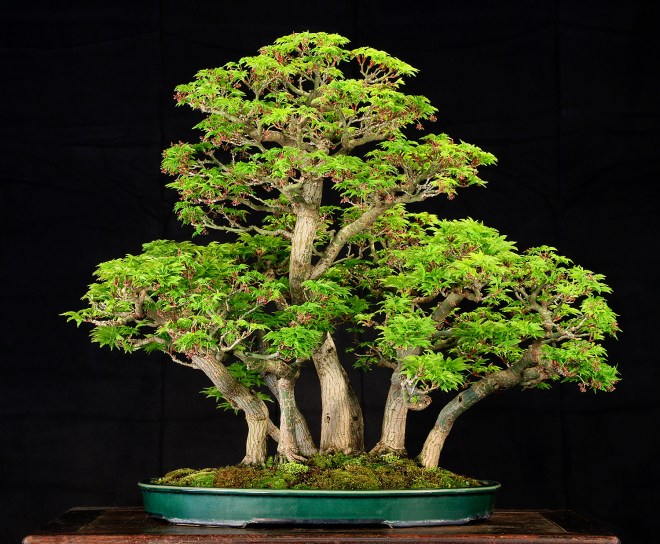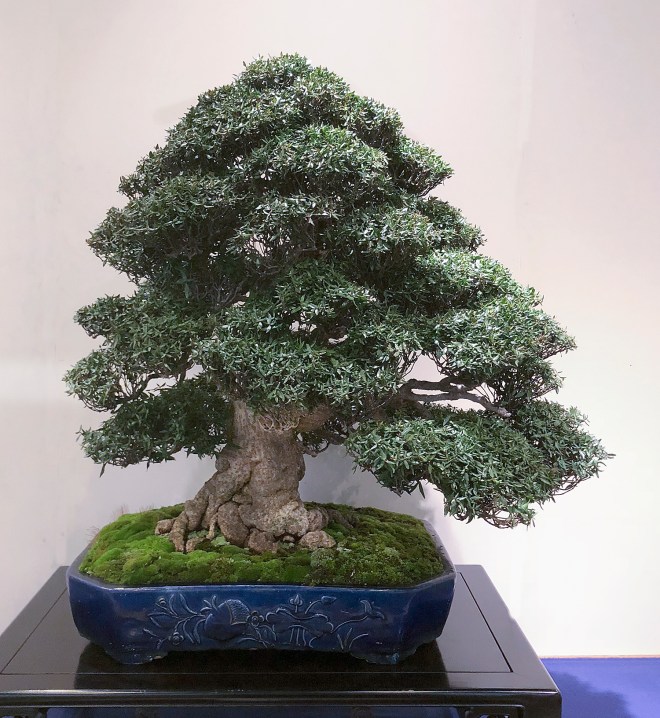
The Rough bark Japanese maple, Acer palmatum ‘Arakawa,’ is a beautiful cultivar that exhibits rough bark, which adds impact to a bonsai. The rough bark is interesting and creates a focal point to the total aesthetic impact the bonsai presents. But, this cultivar does not present a quiet refined image characteristic of Japanese maples with beautiful bark which becomes gray when mature. Fine twigs are difficult to develop and a coarse feeling is usually presented.

Rough bark Japanese maple I started from a cutting about 30 years ago.

A rough bark Japanese maple displayed in Japan, but not the Arakawa cultivar because of the fine bark and fine textured twigs. Perhaps this bonsai was developed from select seedlings or an air layer.


Last autumn was a great year for my large Rough bark Japanese maple garden tree for seed production. Diane collected many seeds and they have been planted. However seedlings have also naturally sown themselves and are coming up in the gravel areas throughout the main display area and in the side gardens near the studio and garage.

Diane has been busy collecting seedlings from the Rough bark Japanese maple garden tree. She and Alan Adair my Senior Assistant have collected nearly 600 seedlings already and more are coming up all over the garden, even in bonsai pots 30 feet away from the parent garden tree. The Rough bark Japanese maple garden tree is one of my cuttings started about 40 years ago.

True Rough bark Japanese maples, Acer palmatum ‘Arakawa,’ must be asexually propagated by cuttings, air layering or grafting. These seedlings cannot the Rough bark Japanese maple cultivar because they are not asexually propagated. However, this parent Rough bark Japanese maple garden tree produces a high percentage of seedlings showing the beautiful rough bark characteristics, which will also develop on the surface roots. Many two and three year old seedlings show the beginnings of rough bark development.
Rough bark Japanese maples are commonly grown for bonsai from cuttings and air layers. Commercially they are quickly produced for the nursery trade by grafting. However grafted Rough bark Japanese maples do NOT exhibit the rough textured bark on the lower trunk and surface roots. Cutting or air layered trees show rough bark on the lower trunk and surface roots. A surface root from my garden tree about six feet away from the trunk has beautiful rough bark.




The seedlings are carefully dug from the ground and gravel areas when the first set of true leaves form. The taproots are cut off using a sharp razor blade and immediately planted in small cell packs and kept in a shady area for a few days. A root inducing hormone is not used. Then they are exposed to full sun in the greenhouse. When the Rough bark Japanese maple seedlings begin to lengthen they will be put outside in a sunny location for the summer.

The following year they are individually potted into three inch pots and some are wired for trunk movement. The curves are rather contorted because as they thicken they will become graceful.

Unwired three year old seedling.

Wired and shaped three year old seedling.
Usually I propagate Rough bark Japanese maples from cuttings or air layers. Semi softwood cuttings are taken in June in my area and placed under mist until rooted, usually in August. They are given maximum winter protection, sometimes in a cool greenhouse and individually potted in spring when new growth begins. Some cuttings I’ve grown, as garden trees are now about 12 feet tall with beautiful rough bark. As the surface roots are exposed the rough bark will also develop.

Grafted Rough bark Japanese maple showing common Japanese maple bark on the surface roots.

Cutting grown and completely container grown Rough bark Japanese maple.
Air layers are usually taken in early or late spring as the new growth begins, but I’ve also air layered them in early summer as well. They usually root in about two to three months and are removed as soon as possible to they can become somewhat established in pots. They are often maintained in a cool greenhouse during the first winter.

The Rough bark Japanese maple is a delightful cultivar to grow and train. Easy to grow without many problems they can be trained into beautiful bonsai in several years. They do not tend to produce new adventitious new buds on the trunk and branches with the rough bark. Desired new branches must be grafted, usually using the inarch technique to add branches in needed area.














































































































































































































































































You must be logged in to post a comment.